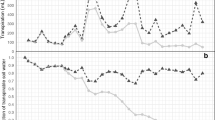Abstract
Polyploidy has an important role in genetic and phenotypic diversity in plant evaluation and breeding potential. Spine gourd (2n = 2x = 28) is one of the most highly nutritious vegetables among the cucurbits. The objective of this study was to establish an efficient method for the induction of autotetraploids in spine gourd through colchicine treatment. For tetraploid induction, spine gourd sprouted tubers were treated with different colchicine concentrations (0.01%, 0.05%, and 0.1%) along with various exposure durations, viz., 8, 10, 12, 24, and 36 h. Treatment with 0.1% colchicine solution for 10 h was found to be more effective in producing autotetraploids. Suspected tetraplopids were subjected to morphological, physiological, and chromosomal observations for their exact confirmation. 9 plants (6%) out of 150 tubers treated were found to be tetraploid, with the highest frequency (%) observed in 0.1% colchicine concentration. The tetraploid plant's flowering was delayed by 11 and 17 days in males and females, respectively. The leaves and flowers of tetraploids were significantly larger; stomata were longer by 56.61%; and chlorophyll content was higher by 53.12%. The tetraploid plants were accompanied by increased stomata size, pollen grain length, and chlorophyll content. Furthermore, differences in morphological and physiological characters between diploids and tetraploids were significant.



Similar content being viewed by others
References
Agarwal, P. K., & Roy, R. P. (1976). Natural polyploids in cucurbitaceae I. Cytogenetical studies in triploid Momordica dioica Roxb. Caryologia, 29(1), 7–13.
Ajalin, I., Kobza, F., & Dolzel, J. (2002). Ploidy identification of double chromosome number plants in ViolaWittrockiana Gams. M1-generation. Horticultural Science (prague), 29, 35–40.
Bharathi, L. K., Munshi, A. D., Vinod, Chandrashekaran, S., Behera, T. K., Das, A. B., John, K. J., & Nath, V. (2011). Cytotaxonomical analysis of Momordica L. (Cucurbitaceae) species of Indian occurance. Journal of Genetics, 90, 21–30.
Bharathi, L. K., Naik, G., Singh, H. S., Dora, D. K., & Peter, K. V. (2007). Spine gourd. Underutilized and underexploited horticultural crops (Vol. 1, pp. 289–295). New Delhi: New India Publishing.
Chopra, V. L., & Swaminathan, M. S. (1960). Induction of polyploidy in watermelon. Proceedings of the Indian Academy of Sciences Section, 8, 57–65.
Dar, T. H., Raina, S. N., & Goel, S. (2013). Molecular analysis of genomic changes in synthetic autotetraploids Phlox drummondii Hook. Biological Journal of the Linnean Society, 110, 591–605.
Gagoi, M., & Basumatary, M. (2018). Estimation of chlorophyll concentration in seven Citrus species of Kokrajhar district, BTAD, Assam, India. Tropical Plant Research, 5, 83–87.
Gaikwad, K. J., Jambhale, N. D., & Bhave, S. G. (2009). Induction of polyploidy in watermelon (Citrullus lanatus (Thunb) Matsum and Nakai). Agricultural & Biological Research, 25(2), 110–118.
Gallone, A., Hunter, A., & Douglas, G. C. (2014). Polyploid induction in vitro using colchicine and oryzalin on Hebe ‘Oratia Beauty’: Production and characterization of the vegetative traits. Scientia Horticulturae, 179, 59–66. https://doi.org/10.1016/j.scienta.2014.09.014
Hassan, J., Miyajima, I., Ozaki, Y., Mizunoe, Y., Sakai, K., & Zaland, W. (2020). Tetraploid induction by colchicine treatment and crossing with a diploid reveals less-seeded fruit production in pointed gourd (Trichosanthes dioica Roxb.). Plants, 9, 370.
Hommo, R. E., & Valanne, A. (1998). Somaclonal variation: Molecular analysis, transformation interaction, and utilization. Plant Breeding Reviews, 16, 229–268.
Janani, P., & Balusamy, A. (2018). Spine gourd an underutilized Cucurbitaceous vegetable. Kerala Karshakan e-Journal, 6(6), 45–47.
Jaskani, M. J., Kwon, S. W., & Kim, H. D. (2005). Comparative study on vegetative, reproductive and qualitative traits of seven diploid and tetraploid watermelon lines. Euphytica, 145, 259–268.
Lan, J. R. (1990). Use of marker gene in producing triploid watermelons. American Society of Horticultural Sciences, 76, 577–581.
Madani, H., Hosseini, B., Dehghan, E., et al. (2015). Enhanced production of scopolamine in induced autotetraploid plants of Hyoscyamus reticulatus L. Acta Physiologiae Plantarum, 37, 55.
Mukherjee, C. F., Hommo, V. S., & Valanne Lan, A. (1971). Production of seedless watermelons. Agricultural Research service, USDA technical bulletin No, 1425.
Podwyszynska, M., Gabryszewska, E., Dyki, B., Stepowska, A. A., Kowalski, A., & Jasinski, A. (2015). Phenotypic and genome size changes (variation) in synthetic tetraploids of daylily (Hemerocallis) in relation to their diploid counterparts. Euphytica, 203, 1–16.
Singh, A. K., & Yadav, K. S. (1983). Cytogenetics of Cucumis L. comparative study of natural and induced polyploids. Cytologia, 49, 183–192.
Soltis, P. S., & Soltis, D. E. (2009). The role of hybridization in plant speciation. Annual Review of Plant Biology, 60, 561–588.
Trivedi, R. N., & Roy, R. P. (1973). Cytogenetics of Momordica charantia and its polyploids. Cytologia, 38, 317–325.
Yang, X., Ye, C. Y., Cheng, Z. M., Tschaplinski, T. J., Wullschleger, S. D., YinW, X. X., & Tuskan, G. A. A. (2011). Genomic aspects of researchinvolving polyploid plants. Plant Cell, Tissue and Organ Culture, 3, 387–397.
Zheng, J., Sun, C., Yan, L., & Feng, Z. (2019). Development of cucumber autotetraploids and their phenotypic characterization. Cytologia, 84, 359–365.
Author information
Authors and Affiliations
Corresponding author
Additional information
Publisher's Note
Springer Nature remains neutral with regard to jurisdictional claims in published maps and institutional affiliations.
Rights and permissions
Springer Nature or its licensor (e.g. a society or other partner) holds exclusive rights to this article under a publishing agreement with the author(s) or other rightsholder(s); author self-archiving of the accepted manuscript version of this article is solely governed by the terms of such publishing agreement and applicable law.
About this article
Cite this article
Nirala, D., Tiwari, J.K., Sahu, N.K. et al. Morphological and physiological changes (variation) in colchicine induced tetraploids of spine gourd (Momordica dioica Roxb.) in comparison to their diploid counterparts. Plant Physiol. Rep. 28, 481–489 (2023). https://doi.org/10.1007/s40502-023-00758-0
Received:
Accepted:
Published:
Issue Date:
DOI: https://doi.org/10.1007/s40502-023-00758-0




